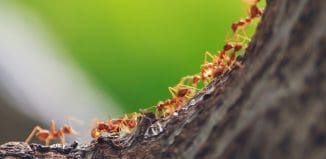All Natural: New “Pheromone” Based Robotic Communication
This post is also available in:  עברית (Hebrew)
עברית (Hebrew)
Swarm robotics, an emerging field in robotics, deals with the coordination of multi-robot systems. In a feat of mechanical bio-mimicry, scientists in the field attempt to replicate communication systems employed by insect swarms in robots. Researchers have so far been unable to replicate fully the pheromone based communications employed by ants, bees, and other species – until now. Specialists at the University of Lincoln, UK may have found the answer.
Previous attempts at replicating pheromone-based communication involved chemical means (like alcohol), light, sound, and other means. None of these attempts have been fully effective. Researchers from the University of Lincoln’s School of Computer Science have solved this problem with a new system that is accurate, reliable, and requires no special components.
The new system uses an LCD screen and a low-cost USB camera to simulate pheromones, and is able to adjust their strength according to set parameters. The robots, on their part, are equipped with two light sensors that mimic an ant’s antennae.
COS-phi (Communication System via Pheromone), as the new system is called, is open source on both hardware and software levels, with a software stack to track trajectories and control “pheromone” release.
“Nature is one of the best sources of inspiration for solutions to different problems in different domains, and this is why swarm robotics has developed into such an important area of study. It takes insights from the behaviours and coordination capabilities of social insects, where the success of a group in accomplishing a task relies heavily on the interactions among its members. Among social insects, the use of pheromones is one of the most effective means of communication, but for the swarm robotics community it has also been one of the most difficult to reproduce,” says Farshad Arvin, lead researcher for the COS-phi project.





























